Page 2 of 3
Re: Submissions: 2023 November
Posted: Fri Nov 17, 2023 10:18 pm
by Chris Peterson
Hidden Galaxy
IC 342, the Hidden Galaxy. So called because it lies behind the dusty plane of the Milky Way. This would be one of the brightest extended objects in the sky but for the obscuring dust. And that dust significantly reddens this galaxy. All of those red areas are ionized hydrogen, driven by young, hot, blue stars. Yet we really don't see those stars... their blue light simply can't make it through the dust. So the entire galaxy looks reddish-yellow, and the only obviously blue stars are much closer to us, with little intervening dust. Most galaxies with this much ionized hydrogen in their arms would have brilliant blue highlights.
Details:
QSI 660 camera on 250mm RC, Astronomic HLRGB filters
192 min H-alpha, 84 min lum, 90 min red, 82 min green, 62 min blue
Processed with PixInsight and Photoshop
Final image resolution 0.69 arcsec/pixel, 21 arcminute wide field
_
Re: Submissions: 2023 November
Posted: Sat Nov 18, 2023 2:58 am
by barretosmed
Needle Galaxy - NGC 4565
BEST DETAILS
https://www.astrobin.com/full/ud4chs/0/
EQUIPMENT:
Esprit 150mm triplet
Zwo asi 6200mc
Mount CEM120
Frames 290X300" (taken advantage of a total of 410)
LOCATION: Munhoz - MG - Brazil
DATES: From 05/13/2023 to 05/25/2023
PROCESSING AND CAPTURE:
Adobe Photoshop, ASTAP, SGP, PHD2 and PixInsight
Author: Fernando Oliveira de Menezes
Email:
Barretosmed@hotmail.com
(Organizing author of the book Amateur Astrophotography in Brazil)
https://clubedeautores.com.br/livro/ast ... -no-brasil
Re: Submissions: 2023 November
Posted: Sat Nov 18, 2023 2:59 am
by barretosmed
Needle Galaxy - NGC 4565
BEST DETAILS
https://www.astrobin.com/full/ud4chs/0/
EQUIPMENT:
Esprit 150mm triplet
Zwo asi 6200mc
Mount CEM120
Frames 290X300" (taken advantage of a total of 410)
LOCATION: Munhoz - MG - Brazil
DATES: From 05/13/2023 to 05/25/2023
PROCESSING AND CAPTURE:
Adobe Photoshop, ASTAP, SGP, PHD2 and PixInsight
Author: Fernando Oliveira de Menezes
Email:
Barretosmed@hotmail.com
(Organizing author of the book Amateur Astrophotography in Brazil)
https://clubedeautores.com.br/livro/ast ... -no-brasil
Re: Submissions: 2023 November
Posted: Sat Nov 18, 2023 9:51 pm
by Mohamedusama19
Title of image
Andromeda in narrow/broad-band with the recently discovered SDSO
Copyright: Mohamed Usama Ismail - Ursamo Astrophotography / Al Sadeem Observatory
Location: Al Sadeem Observatory - Abu Dhabi - UAE
Imaging Telescopes: William Optics ZenithStar 61ii / ZS61ii
Imaging Cameras: ZWO ASI2600MC DUO
Mounts: ZWO AM5
Filters: IDAS LPS-P2 2" · Radian Triad Tri-band 2"
Software: Adobe Photoshop · Aries Productions Astro Pixel Processor (APP) · Pleiades Astrophoto PixInsight
Integration: 95h 20′
Re: Submissions: 2023 November
Posted: Sun Nov 19, 2023 7:56 am
by WolfHeart
Desert Thunderstorm over Egyptian Sand
 Desert Thunderstorm over Egyptian Sand
Desert Thunderstorm over Egyptian Sand by
Ahmed Waddah, on Flickr
After a series of cloudy nights before new moon which was supposed to be clear according to forecasts started with rain which is the first for us in Egypt this season. As soon as the sun started to set a desert thunderstorm started on the distance. I have always wanted to photograph that and captured a series, this image was the best of the series. I know this is common in the States but we don't see much of that in Egypt.
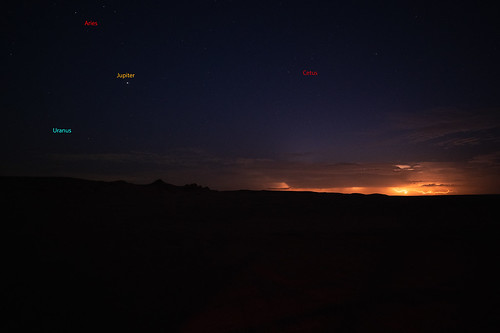 DS IG annotated
DS IG annotated by
Ahmed Waddah, on Flickr
Camera:Nikon Z6II
Lens: Nikon Z14-24mm S F/2.8
Neewer Tripod Leveling Base
Sirui AM-284 Carbon Fiber Tripod
F/2.8 - ISO1600 - 0.8s - 24mm
Al Fayoum Desert
12th of November
Image was processed in Adobe Photoshop and noise reduction was performed in Pixinsight
Image on Astrobin:
https://www.astrobin.com/9z9pny/
Social: Ahmed Waddah
Facebook:
https://www.facebook.com/waddah.photography
Astrobin:
https://www.astrobin.com/users/WolfHeart/
IG:
https://www.instagram.com/waddahphotography/
Re: Submissions: 2023 November
Posted: Sun Nov 19, 2023 2:36 pm
by chassaigne
 Sh2-132 SHO 10h45mnV5
Sh2-132 SHO 10h45mnV5 by
georges chassaigne, sur Flickr
SH2-132, also known as the Leo Nebula, is a rich HII region with star clusters, emission nebulae, and dark dust regions. Located in the southern part of the constellation Cepheus, the Leo Nebula is approximately 10,000 light years from Earth in the Perseus Arm of the Milky Way galaxy.
Full data
https://www.georges-chassaigne.fr/433170348/sh2-132
Re: Submissions: 2023 November
Posted: Sun Nov 19, 2023 2:49 pm
by kbramley
IC 5070 - The Pelican Nebula
The Pelican Nebula, located in the constellation Cygnus roughly 2,000 light years away. It is an active area of star formation resulting in the ionisation of the surrounding gas. Also visible is the fascinating Herbig-Haro object 555 which is formed by narrow jets of partially ionised gas colliding with nearby clouds of dust and gas.
Capture Info:
Over 7 Nights in December 2022 from Lancashire, UK
SII - 8.5 hours (30min subs)
H-Alpha - 8 hours (30min subs)
OIII - 7.5 hours (30min subs)
Equipment:
Skywatcher 190MN
Atik 383L+ mono camera
EFW2 Filter Wheel
Chroma 36mm narrowband filters SII(3nm), H-alpha(5nm) and OIII(3nm)
EQ6 Mount
Thanks for looking
Keith
Instagram: keithbramley
Re: Submissions: 2023 November
Posted: Mon Nov 20, 2023 10:09 am
by astrobureau
Westerhout 5 (LBN 667, LBN 673, Soul Nebula)
Acquisition information:
Exposure: 50xHa, 74xSii, 78xOiii, 300s -10°C each
Bortle scale: 5
Optics: TS 80 f/4.4 6 element APO
Camera: QHY268m
Guide: QHY Off-axis + ASI290
Mount: EQ6-R Pro
Filters: Astronomik SHO 6nm
Software: N.I.N.A, Pixinsight
Data was collected on 12th, 15th, 16th of November 2023.
Thanks for looking and Clear Skies!
Warm wishes from Cyprus.
Vilen.
Instagram:
https://www.instagram.com/astrobureau
Astrobin:
https://www.astrobin.com/users/sharifov/
https://cdn.discordapp.com/attachments/ ... oul_ps.jpg
Re: Submissions: 2023 November
Posted: Mon Nov 20, 2023 10:27 am
by Luca Fornaciari
Under the lights of Orion
It could have been a traditional deep-sky photograph of Barnard's Loop, with its splendid winter nebulas, but instead, something different was born.
I had been eagerly anticipating diving into this genre of images. I admit, I've always loved them, like any new inspiration for night photography. The challenge here is to create a balanced composition, an allure that not only captures attention but feels genuinely authentic.
I don't know if I've created something pleasing, but I can assure you it was fun trying. Finding joy every time I shoot at night is the most important aspect to maintain over time. This justifies every new perspective in an infinite discipline that evolves every day but never fades away.
And now, for those interested in technical details, here are the rules I set for this composition.
The image is a blend of a single terrestrial shot and stacking 23 sky images. Both parts were captured in the same location, on the same night, between 9:30 PM and 11:00 PM, using the same camera and lens.
The landscape photo resulted from a 13-second exposure, while for the sky, I combined 23 images, each lasting 60 seconds, tracked with the MiniTrack LX4.
15 November 2023
Ground: Sony α7 III mod Super UV-IR cut | FE F2.8 Macro 90mm | F/2.8 | 1x13s
Sky: Sony α7 III mod Super UV-IR cut | FE F2.8 Macro 90mm | F/2.8 | MiniTrack LX4 | 23x60s
Developed with PixInsight and Photoshop 2023
Copyright: Luca Fornaciari
Facebook:
https://www.facebook.com/lucafornaciariphotography
IG : luca_fornaciari_photography
Website:
www.lucafornaciarifotografia.com
I like to appear in the APOD discussion forum Asterisk.
I agree all of terms.
Luca Fornaciari
Re: Submissions: 2023 November
Posted: Mon Nov 20, 2023 1:59 pm
by Victor Lima
I've just returned from Iceland, where I was with the 4th group of my Photo Tour through the Land of Fire and Ice. The greatest anticipation when thinking about a year-end tour in Iceland is the opportunity to photograph the Northern Lights at some of the country's major natural attractions, and there are plenty of them.
Each time in Iceland is different; the weather conditions vary greatly throughout the days of the journey, and on each occasion, we witness different situations in the places we visit. Despite this, we've been very lucky in the Kirkjufell mountain region, where in the last 3 expeditions, we had incredible weather and Northern Lights conditions.
This 360-degree panoramic image was captured on November 9th, the second day of our expedition in Iceland. The day was amazing from dawn until night, when we had a spectacular Northern Lights show over Kirkjufell. Unfortunately, at the moment when the Northern Lights were strongest and most active, I couldn't take photos as I was assisting my students. A bit later, when it was weaker, I managed to capture this shot, and I was very happy with the result.
EXIF:
09/nov/2023
Canon 6D Ha-mod / Rokinon 12mm f/2.8 Fisheye
12x 15sec / f:2.8 / ISO 6400
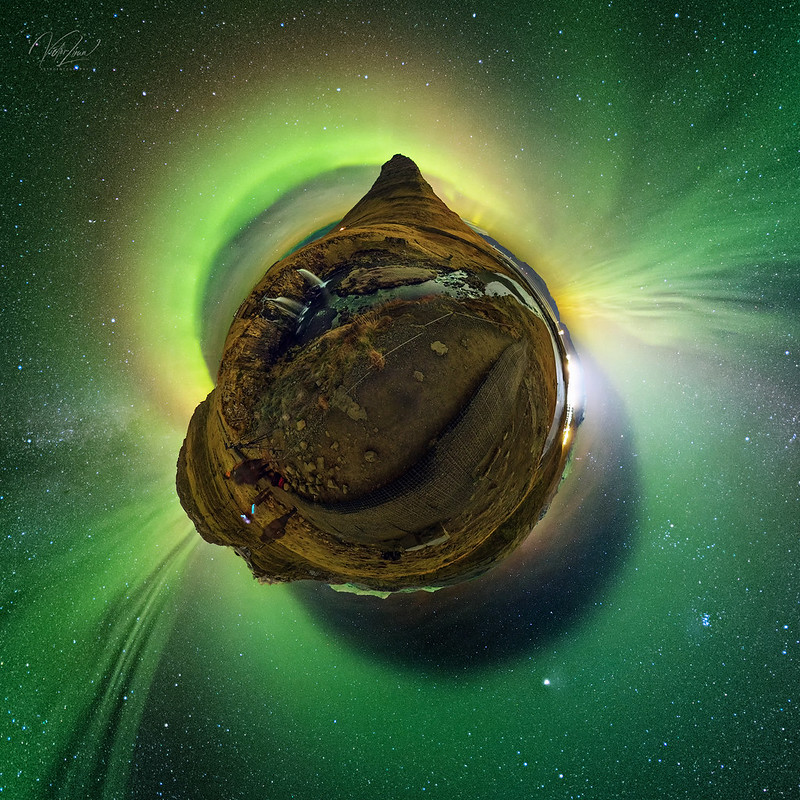 A Planet Called ICELAND
A Planet Called ICELAND by
Victor Lima, no Flickr
Re: Submissions: 2023 November
Posted: Mon Nov 20, 2023 2:24 pm
by Victor Lima
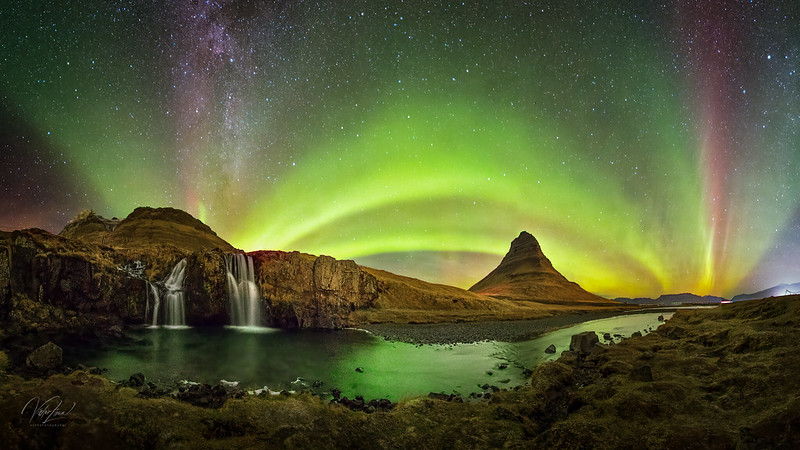 Iceland
Iceland by
Victor Lima, no Flickr
I've just returned from Iceland, where I was with the 4th group of my Photo Tour through the Land of Fire and Ice. The greatest anticipation when thinking about a year-end tour in Iceland is the opportunity to photograph the Northern Lights at some of the country's major natural attractions, and there are plenty of them.
Each time in Iceland is different; the weather conditions vary greatly throughout the days of the journey, and on each occasion, we witness different situations in the places we visit. Despite this, we've been very lucky in the Kirkjufell mountain region, where in the last 3 expeditions, we had incredible weather and Northern Lights conditions.
This panoramic image was captured on November 9th, the second day of our expedition in Iceland. The day was amazing from dawn until night, when we had a spectacular Northern Lights show over Kirkjufell. Unfortunately, at the moment when the Northern Lights were strongest and most active, I couldn't take photos as I was assisting my students. A bit later, when it was weaker, I managed to capture this shot, and I was very happy with the result.
EXIF:
09/nov/2023
Canon 6D Ha-mod / Rokinon 12mm f/2.8 Fisheye
12x 15sec / f:2.8 / ISO 6400
Re: Submissions: 2023 November
Posted: Mon Nov 20, 2023 3:34 pm
by the_astronomy_enthusiast
 SNR G126.2+01.6 and surroundings (first color image)
SNR G126.2+01.6 and surroundings (first color image) by
William Ostling, on Flickr
Another project from the New Horizon by Tim Schaeffer, me and Sendhil Chinnasamy. This is the first ever color image of the SNR G126.2+01.6 and surroundings!
SNR G126.2+01.6 was partially imaged by Nicolas Outters in 2020: SNR G126.2+01.6 – Outter’space Astrophotography (outters.fr)
We took on this region to image this low surface brightness SNR and its surrounding regions. Imaging was done in Sendhil’s backyard, which is slowly becoming light polluted. In the course of imaging, he ran into halos with the O3 filter, and had to get Chroma replace it with their F/3 version once he explained his imaging train.
Website: <a href="
https://theastroenthusiast.com/" rel="noreferrer nofollow">theastroenthusiast.com/</a>
Instagram: <a href="
https://www.instagram.com/the_astronomy_enthusiast/" rel="noreferrer nofollow">
www.instagram.com/the_astronomy_enthusiast/</a>
Credits: Sendhil Chinnasamy, William Ostling, Tim Schaeffer
Re: Submissions: 2023 November
Posted: Mon Nov 20, 2023 6:56 pm
by the_astronomy_enthusiast
 Fleming's Triangular Wisp
Fleming's Triangular Wisp by
William Ostling, on Flickr
Full post here:
https://theastroenthusiast.com/flemings ... ular-wisp/
In this stunning cosmic portrait, we are shown a celestial spectacle that showcases the scream of a dying star. The image is a tapestry woven by the filaments of glowing gas, a testament to the rich lives of stars and the beautiful remnants that they leave in their wake.
Chaotic in appearance, these tangled filaments of shocked, glowing gas are spread across planet Earth’s sky toward the constellation of Cygnus as part of the Veil Nebula. The Veil Nebula itself is a large supernova remnant, an expanding cloud born of the death explosion of a massive star. Light from the original supernova explosion likely reached Earth over 5,000 years ago. The glowing filaments are really more like long ripples in a sheet seen almost edge on, remarkably well separated into the glow of ionized hydrogen atoms shown in blue and oxygen in red hues. Also known as the Cygnus Loop and cataloged as NGC 6979, the Veil Nebula now spans about 6 times the diameter of the full Moon. The length of the wisp corresponds to about 30 light years, given its estimated distance of 2,400 light years. Often identified as Pickering’s Triangle for a director of Harvard College Observatory, it is also named for its discoverer, astronomer Williamina Fleming, as Fleming’s Triangular Wisp.
Website:
https://theastroenthusiast.com/
Instagram:
https://www.instagram.com/the_astronomy_enthusiast/
Heart of the Swan - Gamma Cygni
Posted: Mon Nov 20, 2023 8:11 pm
by Robservatory
Heart of the Swan Gamma Cygni
Here is my widefield image of Gamma Cygnus (Sadr Region) shot from my Bortle 8/9 rooftop in Vancouver, Canada. I created this image over the nights of September 7, 8, and 12th for a total of 33 hours of imaging time. I used my full frame Sony A7R, Altair Astro 4nm HA/OIII and SII/OIII filters with my Redcat 51 telescope.
The Sadr Region, located in the constellation of Cygnus (the Swan), is a prominent stellar formation within the Northern Cross asterism. It's identified by the brilliant star Sadr (Gamma Cygni), a supergiant situated in the heart of the Cygnus constellation. This area is known for its rich star-forming regions, including emission and reflection nebulae, creating a visually stunning celestial landscape.
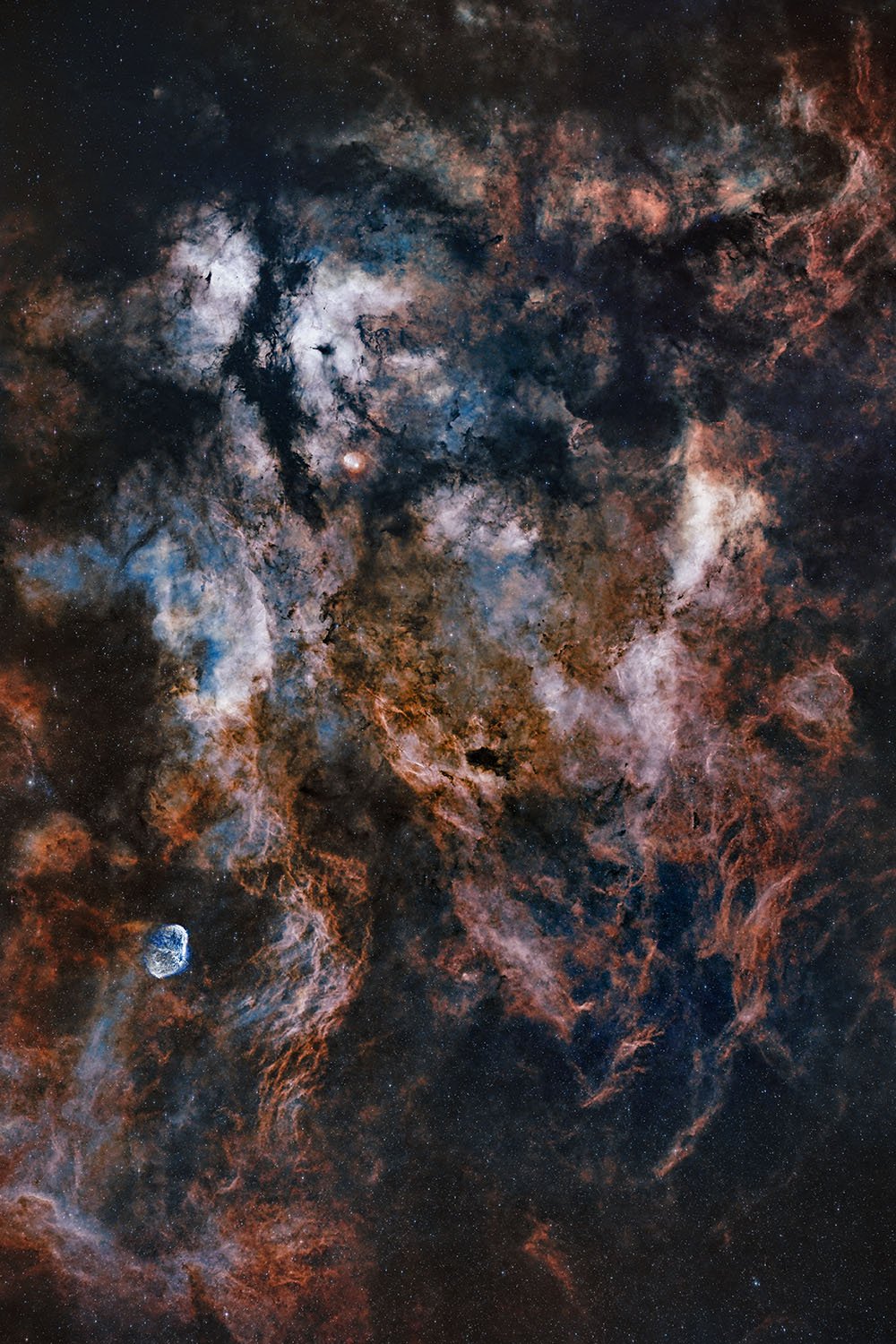
Re: Submissions: 2023 November
Posted: Tue Nov 21, 2023 4:13 pm
by Galactic-Hunter
M78 is the brightest diffuse reflection in the night sky and looks great when photographed with a telescope, but can also be captured wide-field using a camera and lens.
This picture was taken under Bortle 2 skies using the RASA f/2, ASI2600MC and no filters. 27 hours total.
More info:
https://www.galactic-hunter.com/post/messier78
 Dusty M78
Dusty M78
Credit:
Antoine Grelin -
https://www.galactic-hunter.com/
Re: Submissions: 2023 November
Posted: Wed Nov 22, 2023 12:25 am
by Victor Lima
I've just returned from Iceland, where I was with the 4th group of my Photo Tour through the Land of Fire and Ice. The greatest anticipation when thinking about a year-end tour in Iceland is the opportunity to photograph the Northern Lights at some of the country's major natural attractions, and there are plenty of them.
Each time in Iceland is different; the weather conditions vary greatly throughout the days of the journey, and on each occasion, we witness different situations in the places we visit. Despite this, we've been very lucky in the Kirkjufell mountain region, where in the last 3 expeditions, we had incredible weather and Northern Lights conditions.
This panoramic image was captured on November 9th, the second day of our expedition in Iceland. The day was amazing from dawn until night, when we had a spectacular Northern Lights show over Kirkjufell. Unfortunately, at the moment when the Northern Lights were strongest and most active, I couldn't take photos as I was assisting my students. A bit later, when it was weaker, I managed to capture this shot, and I was very happy with the result.
EXIF:
09/nov/2023
Canon 6D Ha-mod / Rokinon 12mm f/2.8 Fisheye
12x 15sec / f:2.8 / ISO 6400
 Aurora Substorm in Iceland
Aurora Substorm in Iceland by
Victor Lima, no Flickr
Re: Submissions: 2023 November
Posted: Wed Nov 22, 2023 4:41 am
by kwalker
IC 1795 and NGC 896 (The Fish Head)
An Emission Nebula in the Constellation of Cassiopeia in the region of the Heart Nebula
At 6000 light years from earth and a span of 60 light years across, the area is full of nebulosity exited by ionized gasses from neighboring stars.
Total Interrogation time 29 hours with 5-minute RGB and 15-minute SII HA and OIII subs processed in that order
The Ha data was used for the Luminance layer
Stellarvue SVX130T-Raptor
SFFX1 Flattener
MallinCam DS26M-TEC – Chroma filters 5nm 36mm unmounted
Paramount MYT
SG-PRO
PixInsight
Ken Walker
https://www.astrobin.com/full/556gdw/B/

Re: Submissions: 2023 November
Posted: Wed Nov 22, 2023 7:21 pm
by starsoverbucks
The Orion Nebula
Telescope: 8” RASA f/2
Camera: Zwo ASI2600MC Pr
Exposure: 290 x 1min, 30 x 5s
Mount: Zwo AM5
Guiding: Zwo ASI120mini, 30mm scope
Filter: Optolong L Quad Enhance
Software: ASI Air, DSS, Pixinsight
Re: Submissions: 2023 November
Posted: Thu Nov 23, 2023 3:42 am
by Astrodude13
 Pleiades Reprocessed 2023
Pleiades Reprocessed 2023 by
Blake Estes, on Flickr
The APOD awarded image from December 2022, Has been very carefully reprocessed using new techniques to reveal previously hidden Hydrogen emissions and reflection nebula detail.
Technical details are as follows:
Paramount ME
Celestron C14 Edge HD
Starizona Hyperstar 14 V4
Optolong L-Pro Luminance filter
ZWO ASI 6200MC Color Camera
276x120sec exposures
Processed in APP and Lightroom
Aurora HDR
Re: Submissions: 2023 November
Posted: Fri Nov 24, 2023 1:01 pm
by Astrodude13
 Orion Nebula Complex
Orion Nebula Complex by
Blake Estes, on Flickr
Technical Details:
Collaboration with Christian Sasse
89x120 sec
ZWO 6200MC
Optolong L-Pro Filter
C14 Edge HD w/ Hyperstar V4
From Siding Spring Australia
Paramount ME
Pixinsight
Lightroom
Photoshop
GraXpert
Re: Submissions: 2023 November
Posted: Fri Nov 24, 2023 4:27 pm
by DrChaos
NGC1333 and Dark nebula regions in Tauro
Last weekend we had wonderful nights in the Wirikuta desert within the astrolandscape workshop. I took also my deep-sky equipment there and shot to this impressive region of the sky.
Epsilon 160 + ZWO EAF
Sky Watcher EQ6R
ZWO ASI2600 Duo
255x180s, -10°, Gain 0, Offset 50,
Darks, flats, dark-flats
PI, Darktable
Wadley, SLP , México, Noviembre 2023
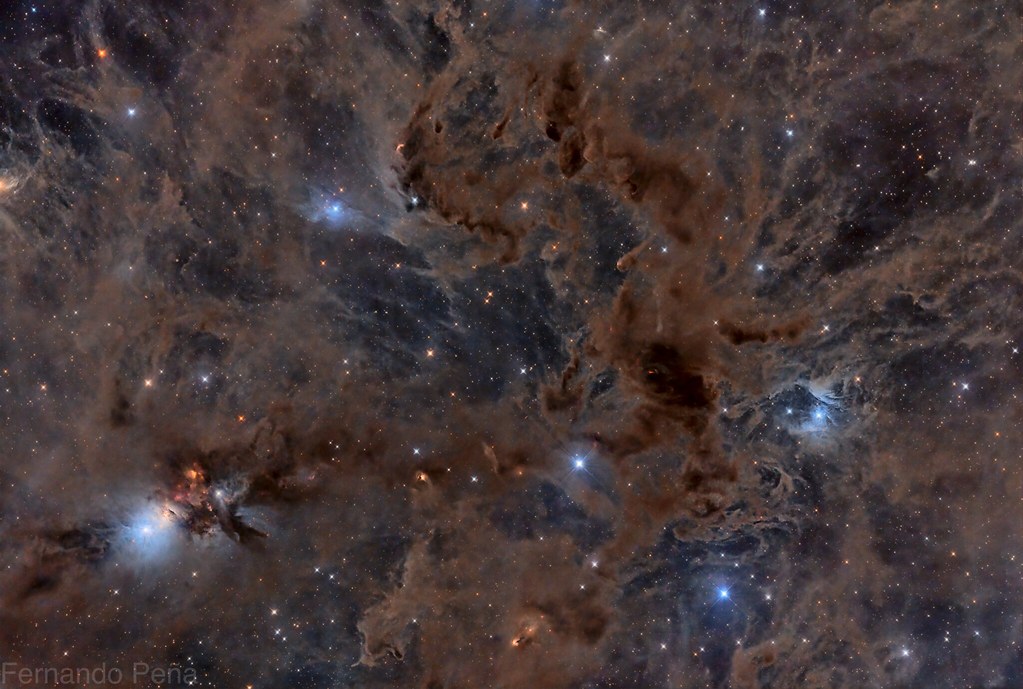
Copyright: Fernando Peña
drcaosastrophoto, on Flickr
fdopc, on Instagram
DrChaos, on Astrobin
Re: Submissions: 2023 November
Posted: Sun Nov 26, 2023 10:37 am
by a.carrozzi
The star-forming region around NGC 6726 in the southern constellation of Corona Australis (Southern Crown) about 400 – 500 light years distant is a complex association of dust and beautiful blue reflection nebula. In the image, the globular cluster NGC 6723 is also seen. Though prospectively near the nebulae, its ancient stars actually lie nearly 30,000 light-years away, far beyond the young stars of the Corona Australis dust clouds.
Technical data: Takahashi Epsilon 180mm f/2.8. ZWO ASI 2600MM. 18x120s L, 3x120s RGB
 NGC6726 and surroundings
NGC6726 and surroundings by
Alessandro Carrozzi, su Flickr
Re: Submissions: 2023 November
Posted: Sun Nov 26, 2023 11:42 am
by Lucadinoi
The Pleiades (also known as the Seven Sisters, the Little Mother or by the acronym M45 from Charles Messier's catalog) are an open cluster visible in the constellation of Taurus. This rather close cluster (440 light years) has several stars visible to the naked eye. In city environments only four or five of the brightest stars are visible, in a darker place up to twelve. All components are surrounded by light reflection nebulae, especially observable in long exposure photographs taken with telescopes of considerable size.
Acquisition Telescope
Tecnosky APO Triplet 152/1216
Acquisition Chamber
Omegon VeTec 571C latest version
Mounting
iOptron CEM120
Homemade flat box, with Ascom 50x50 dimmer
Filters
Optolong L-Pro
Optolong L-Ultimate
Accessories
Primaluce Lab SESTO SENSO 2 • WandererRotator • Electronic control of anti-condensation bands • ZWO 7x2" filter wheel • Riccardi flattener 0.75x
Software
Adobe Photoshop · Astrometric STAcking Program (ASTAP) · iOptron ASCOM Driver and Commander · Planewave Platesolve2 · Pleiades Astrophoto PixInsight · Stark Labs PHD Guiding · Stefan Berg Nighttime Imaging 'N' Astronomy (N.I.N.A. / NINA)
Guiding Telescope
Omegon 90/500
Driving Room
Asi Zwo 224MC
Second test with this setup, together with Marcello Carrieri
35 300s lights with L-Pro filter
Gain 100. Offset 500 Temp -5°
31 flats and 11 darks
Image full resolution
https://flic.kr/p/2phPToU
Re: Submissions: 2023 November
Posted: Mon Nov 27, 2023 3:03 pm
by jlndfr
--- NEW DISCOVERY : Strottner-Drechsler Object 59 ---
Here is the first image of the object StDr59 :
Copyright : Julien Dufour / Marcel Drechsler
This is a discovery by Xavier Strottner and Marcel Drechsler.
The data were collected by Julien Dufour.
The image was processed by Marcel Drechsler.
A few words from Marcel Drechsler about StDr59 :
The object Strottner-Drechsler 59, officially registered under the catalog number PN-G: 196.9-01.5, is considered a possible planetary nebula with a diameter of 73.8 arcmin. The reason for this assessment was the conspicuous circular appearance and a potential central star (a probable white dwarf). The possible central star is slightly offset from the center of the nebula, but this is not an exclusion criterion, as the nebula could already be very old and the central star could have migrated out of the center due to its proper motion.
However, there are also other explanations for the round shape of StDr 59.
For example, it could be a bubble of interstellar ionized gas (ISM).
The signal of doubly ionized oxygen (OIII) that surrounds the bubble of ionized hydrogen (H-alpha) like an envelope is striking. This is usually reversed in planetary nebulae, so (OIII) is closer to the central star than H-alpha.
Hard to miss is a red-blue band of filigree filaments running through the left part of the image. This structure is a little-known supernova remnant - the MonoGem ring. With a diameter of more than two dozen degrees in the night sky, it is the largest known supernova remnant. The image shows the westernmost part of this titan and represents less than 1 percent of the total area of the MonoGem SNR.
All the détails about the discovery here :
https://www.astrobin.com/1fmvfy/
https://cdn.astrobin.com/thumbs/Fpx5Mgs ... TZ0INm.jpg
Re: Submissions: 2023 November
Posted: Mon Nov 27, 2023 7:49 pm
by the_astronomy_enthusiast
 Radio Version - Echoes of Stellar Demise: Tracing Cassiopeia A's Supernova Remnant using 525 Hours of integration
Radio Version - Echoes of Stellar Demise: Tracing Cassiopeia A's Supernova Remnant using 525 Hours of integration by
William Ostling, on Flickr
 SHOO version - Echoes of Stellar Demise: Tracing Cassiopeia A's Supernova Remnant using 525 Hours of integration
SHOO version - Echoes of Stellar Demise: Tracing Cassiopeia A's Supernova Remnant using 525 Hours of integration by
William Ostling, on Flickr
 Echoes of Stellar Demise: Tracing Cassiopeia A's Supernova Remnant using 525 Hours of integration
Echoes of Stellar Demise: Tracing Cassiopeia A's Supernova Remnant using 525 Hours of integration by
William Ostling, on Flickr
Full details here:
https://www.astrobin.com/ug8i0t/
Cassiopeia A, SNR G111.7-02.1, or Cas A for short, is a supernova remnant (SNR) in the constellation of Cassiopeia that lies at a distance of roughly 11.000 lightyears and spans 10 lightyears in diameter.
What makes this SNR so special is that it’s the leftover of the second most recent supernova, dating back to approximately 1681. This makes it a very interesting target for professional research as it holds valuable information about the different stages of a supernova as well as of the different processes going on in a supernova.
In fact Cas A is one of the best studied objects in the night sky, especially in the realm of SNR’s, which is due to its proximity and young age. It already has proved valuable in understanding nucleosynthesis processes, shock physics and evolution of SNR’s amongst many other things.
For the Deep Sky Collective (DSC) “Cassiopeia A” was an interesting target as it lacks deep integrations and detailed looks from any amateurs, seemingly being forgotten about by non-professionals.
After our deep look at M51 we decided to split the DSC into 2 groups, one with big FOV’s and one with small FOV’s - this proved to be extremely useful as it enabled us to use the narrow FOV’s for Cassiopeia A. We ended up with a total of 13 people working on Cas A - 1 Editor, 1 stacker and 11 photographers.
Being determined to go deep and do Cas A some justice amongst amateurs, we started in mid August and ended up with a total of 525h 54min of integration after rejecting bad frames. This not only marks the longest integration time ever on Cas A from any group of amateurs, but also the longest integration time ever on a single panel here on astrobin and possibly even for all of amateur astrophotography (for the moment ). If anybody knows what is the most integration on a single image ever done let us know in the comments!
As the target lacked any good amateur observation we did not really know what to expect in our final stack - more on the results in a later section of the text. Other than not knowing what to expect in the final stack, we also did not know how to split the integration between channels. In the end we went for a traditional SHO palette as this is the traditional way to shoot SNRs and PNs. To our surprise the SNR has a relatively strong signal in Sii and Oiii and barely any signal in Ha - more on that later.
Just a few days before stacking we looked up some existing images of Cas A and saw that some parts of the SNR don’t show in narrowband but are broadband only (i.e emit light in wavelengths that we don’t have special filters for). As we only had a few hours of broadband by that point we shifted focus and got some more of it in the remaining time. In the end it wasn’t crucial but does add some value to the image.
Credits: The Deep Sky Collective:
Tim Schaeffer
William Ostling
Justin
Adrien Keijzer
Paul Kent
BTB Astroteam Brentenriegel
Steve Gill
Tino Heuberger
Nicolas Puig
Julian Shapiro
Felix Schöfbänker
Mikhail Vasilev
David Wood



















